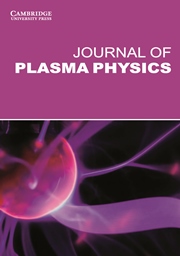Crossref Citations
This article has been cited by the following publications. This list is generated based on data provided by
Crossref.
1991.
The magnetohydrodynamics of energy release in solar flares.
Philosophical Transactions of the Royal Society of London. Series A: Physical and Engineering Sciences,
Vol. 336,
Issue. 1643,
p.
363.
Jardine, M.
Allen, H. R.
Grundy, R. E.
and
Priest, E. R.
1992.
A family of two‐dimensional nonlinear solutions for magnetic field annihilation.
Journal of Geophysical Research: Space Physics,
Vol. 97,
Issue. A4,
p.
4199.
Priest, E. R.
and
Forbes, T. G.
1992.
Magnetic flipping: Reconnection in three dimensions without null points.
Journal of Geophysical Research: Space Physics,
Vol. 97,
Issue. A2,
p.
1521.
Yan, M.
Lee, L. C.
and
Priest, E. R.
1992.
Fast magnetic reconnection with small shock angles.
Journal of Geophysical Research: Space Physics,
Vol. 97,
Issue. A6,
p.
8277.
Priest, E. R.
and
Forbes, T. G.
1992.
Does fast magnetic reconnection exist?.
Journal of Geophysical Research: Space Physics,
Vol. 97,
Issue. A11,
p.
16757.
Yan, M.
Lee, L. C.
and
Priest, E. R.
1993.
Magnetic reconnection with large separatrix angles.
Journal of Geophysical Research: Space Physics,
Vol. 98,
Issue. A5,
p.
7593.
Galeev, A A
1994.
Nonlinear limits of magnetic reconnection.
Physica Scripta,
Vol. T52,
Issue. ,
p.
13.
Strachan, N. R.
and
Priest, E. R.
1994.
A general family of nonuniform reconnection models with separatrix jets.
Geophysical & Astrophysical Fluid Dynamics,
Vol. 74,
Issue. 1-4,
p.
245.
Brown, J. C.
Correia, E.
Fárník, F.
Garcia, H.
Hénoux, J. -C.
La Rosa, T. N.
Machado, M. E.
Nakajima, H.
and
Priest, E. R.
1994.
Energy release in solar flares.
Solar Physics,
Vol. 153,
Issue. 1-2,
p.
19.
Priest, E. R.
Titov, V. S.
Vekestein, G. E.
and
Rickard, G. J.
1994.
Steady linear X‐point magnetic reconnection.
Journal of Geophysical Research: Space Physics,
Vol. 99,
Issue. A11,
p.
21467.
Priest, E. R.
Parnell, C. E.
and
Rickard, G. J.
1994.
Cosmical Magnetism.
p.
11.
Priest, Eric R.
1994.
Plasma Astrophysics.
Vol. 24,
Issue. ,
p.
1.
Lin, Y.
and
Lee, L. C.
1994.
Structure of reconnection layers in the magnetosphere.
Space Science Reviews,
Vol. 65,
Issue. 1-2,
p.
59.
Priest, Eric R.
1995.
Flares and Flashes.
Vol. 454,
Issue. ,
p.
1.
Priest, Eric R.
1995.
Solar Flares.
International Astronomical Union Colloquium,
Vol. 151,
Issue. ,
p.
2.
Vekstein, G. E.
and
Priest, E. R.
1995.
Nonlinear magnetic reconnection with collisionless dissipation.
Physics of Plasmas,
Vol. 2,
Issue. 8,
p.
3169.
Gonález, Alejandro G.
and
Heyn, Martin
1995.
A self-similar solution of dissipative MHD for a jet in the boundary-layer approximation.
Journal of Plasma Physics,
Vol. 53,
Issue. 1,
p.
49.
Jamitzky, Ferdinand
and
Scholer, Manfred
1995.
Steady state magnetic reconnection at high magnetic Reynolds number: A boundary layer analysis.
Journal of Geophysical Research: Space Physics,
Vol. 100,
Issue. A10,
p.
19277.
Priest, E. R.
and
Démoulin, P.
1995.
Three‐dimensional magnetic reconnection without null points: 1. Basic theory of magnetic flipping.
Journal of Geophysical Research: Space Physics,
Vol. 100,
Issue. A12,
p.
23443.
Priest, Eric R.
1996.
Coronal heating by magnetic reconnection.
Astrophysics and Space Science,
Vol. 237,
Issue. 1-2,
p.
49.

